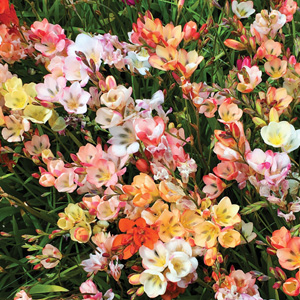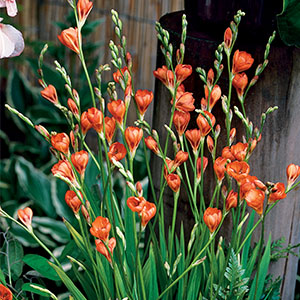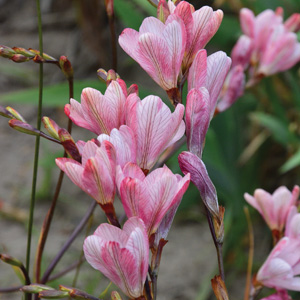Tritonia Growing Guide

What is Tritonia?
Tritonia (Tritonia crocata) also known as Flame Freesia or Blazing Star is a frost and drought hardy upright herbaceous bulb. It comes from the iris family Iridaceae and is native to South Africa. Tritonia are hardy plants have tall rod-shaped stems that jut upwards from their green strappy foliage and are covered in tiny flowers that open from the top of the stem first and work their way down to the bottom. They flower during Spring and come in a few different varieties. Flower colours range from orange, white or pink with shades in between where each flower stem can have between 5 to 10 flowers. Tritonia will multiply. They need to be grown in full sun; however they need to be sheltered from strong winds.
Benefits of Growing Tritonia
Tritonia are similar to Freesias, they have taller stems and naturalise more effectively. They have no fragrance which means they are a good addition for allergy sufferers who find scented gardens difficult to cope with.
Tritonia go very well in rock gardens and containers or planted in groups for best effect in a sunny border. They would suit a cottage garden very nicely.
How to Grow Tritonia
Climatic Zones
Suitable for all climates except tropical.
Plant Size
Height: 20-50cm, Width: 10cm
When To Plant Tritonia
Plant in Autumn.
Soil Preparation
They prefer well drained and fertile soil so prepare the soil by digging through broken down animal manure or compose. Add some slow release fertiliser when planting.
How To Plant Tritonia
Plant in full sun, 8-10cm apart with the bulb at a depth of 5cm under the soil.
Tritonia Plant Care
Regular watering is needed during late Winter into Spring before the flowers appear. The plants should remain fairly dry during Summer and most of Autumn after flowering has finished. Water is more important to Tritonia prior to flowering.
The bulbs prefers an addition of slow release granules to soil prior to planting or fertilise 6 weeks after shoots appear.
Digging and lifting the bulbs are only necessary when clumps become too thick. Dig them up only after the foliage has turned yellow as this is when the bulb has finished storing energy for the next season.
Aphids may attack the developing flowering buds as the weather warms up. Watch out for snails and slugs as the new growth begins to shoot.
Recommended Tritonia Varieties
Tritonia is a striking, Spring flowering plant with fiery orange, creamy white or vibrant pink flower sprays and a fan of short, lance-shaped leaves. It is free-flowering, makes an ideal container and rock garden subject, and multiplies rapidly.


-300x300.jpg)







